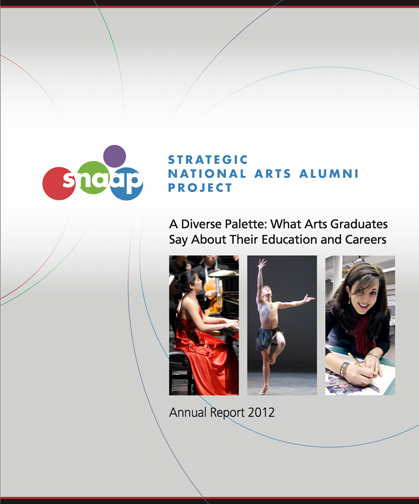
This is a condensed version of my full Arts Policy Library write-up on the Strategic National Arts Alumni Project (SNAAP). Please check out the latter for a more comprehensive discussion of their report.
Is an arts degree worth it or worthless? Many an art or art history major has had to defend the value of her studies. Indeed, in a Kiplinger article that used data from payscale.com and Georgetown University’s Center on Education and the Workforce to determine the “Worst College Majors for Your Career,” fine arts, studio arts, film/photography, graphic design, drama and theater arts all made the list. The article claims that recent arts graduates have higher unemployment rates and are more likely to wind up working in retail than those who chose other majors. But the recent Strategic National Arts Alumni Project (SNAAP) report, “A Diverse Palette: What Arts Graduates Say About Their Education and Careers” indicates that post-graduation life is not so bad for arts alumni. SNAAP’s report found that:
- The unemployment rate for arts alumni is less than half the unemployment rate for all Americans, and about equivalent to the unemployment rate for college graduates.
- The overwhelming majority (92%) of SNAAP respondents reported either a “good” or “excellent” experience at their alumni institution and most would “do it all over again” if given the chance.
- More than three-quarters of currently employed arts alumni are “somewhat” or “very” satisfied with their primary job.
- More than two-thirds of arts alumni remain active in the arts community by creating, exhibiting and performing.
- Arts alumni are significantly more likely than the average American to have volunteered their time or donated money to an arts organization or artist in the past year.
However, when we look further into SNAAP’s research, the following stand out as issues:
- The possibility that SNAAP’s respondents aren’t representative of arts alumni as a whole, for the following reasons:
- the survey only reaches graduates who have maintained valid contact information with their school or who can be located using a service called Harris Connect
- the survey is exclusively online and takes 20-30 minutes to complete, possibly rendering it less attractive for alumni who lack consistent internet access in their homes or don’t feel strongly about their relationship with their alma mater
- institutions pay to participate in SNAAP, which may indicate that participating institutions are already paying above average attention to their students and alumni
- a disproportionate number of the participating institutions appear to have top-ranked arts programs, based on an analysis of visual arts fields; graduates from these programs may be better-off and happier with their education than the average arts alumni
- The potential conflict inherent in using data from paying institutions to create a field research report
- SNAAP used different measures than the Georgetown Center on Education and the Workforce study or the Bureau of Labor Statistics (BLS) to collect employment figures; SNAAP’s method includes intermittent work as employment, making accurate comparisons impossible
- The survey does not ask its respondents to consider their opportunity costs when making subjective judgments about the value of their education
Ultimately, the SNAAP report is largely inconclusive, in large part due to the questions about its representativeness and because one of the few metrics that could potentially serve as a common yardstick with other fields of study is complicated by SNAAP’s alternative approach to measuring employment status. Still, SNAAP is the most comprehensive data resource available for pre-professional arts education, and reminds us that an education should be valued for more than the average earning potential of its graduates.